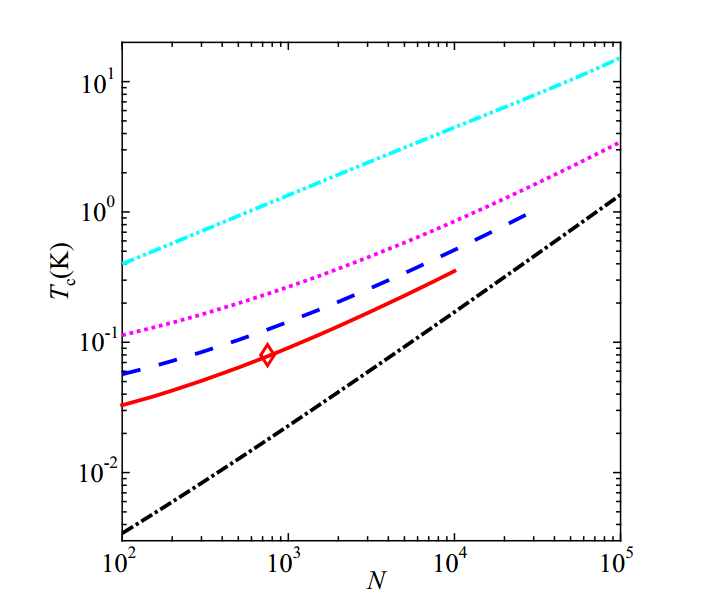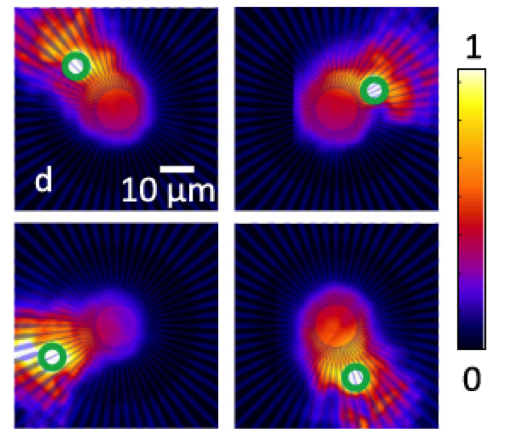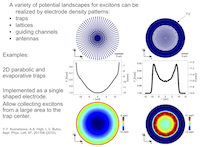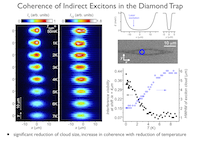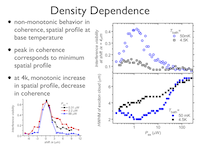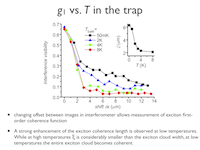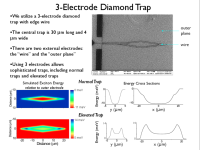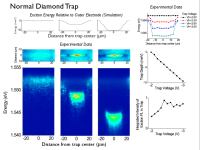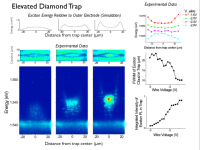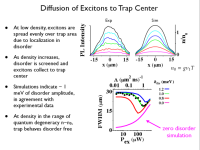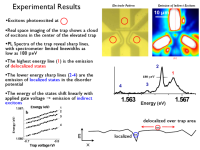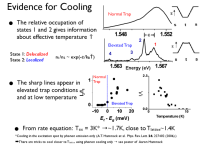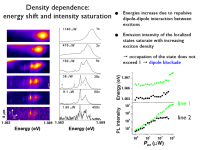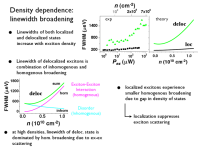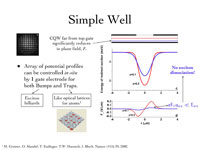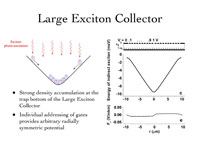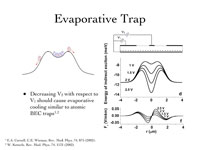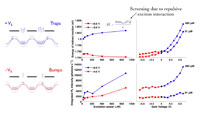Condensation in traps |
|
We present theoretical studies of condensation of indirect excitons in a trap. Our model quantifies the effect of screening of the trap potential by indirect excitons on exciton condensation. The theoretical studies are applied to a system of indirect excitons in a GaAs/AlGaAs coupled quantum well structure in a diamond-shaped electrostatic trap where exciton condensation was studied in earlier experiments. The estimated condensation temperature of the indirect excitons in the trap reaches hundreds of milliKelvin. S.V. Lobanov, N.A. Gippius, L.V. Butov. Theory of condensation of indirect excitons in a trap, arXiv:1609.00357 (2016), Phys. Rev. B 94, 245401 (2016). |
|
Snowflake traps |
|
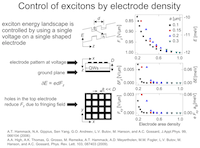
|
We present experimental proof of principle for two-dimensional electrostatic traps for indirect excitons. A confining trap potential for indirect excitons is created by a snowflake-shaped electrode pattern. We demonstrate collection of indirect excitons from all directions to the trap center and control of the trap potential by voltage. Y. Y. Kuznetsova, P. Andreakou, M. W. Hasling, J. R. Leonard, E. V. Calman, L. V. Butov, M. Hanson, and A. C. Gossard, Two-dimensional snowflake trap for indirect excitons, Opt. Lett. 40, 589 (2015). Y. Y. Kuznetsova, A. A. High, and L. V. Butov, Control of excitons by laterally modulated electrode density, Appl. Phys. Lett. 97, 201106 (2010). |
Spontaneous coherence of indirect excitons in a trap |
|
We report on the emergence of spontaneous coherence in a gas of indirect excitons in an
electrostatic trap. At low temperatures, the exciton coherence length becomes much larger
than the thermal de Broglie wavelength and reaches the size of the exciton cloud in the trap.
A.A. High, J.R. Leonard, M. Remeika, L.V. Butov, M. Hanson, A.C. Gossard, Condensation of excitons in a trap, arXiv:1110.1337v2 (2011), Nano Lett. 12 (5), 2605-2609 (2012). A.A. High, J.R. Leonard, M. Remeika, L.V. Butov, M. Hanson, A.C. Gossard, Condensation of Excitons in a Trap, CLEO/QELS, May 7-11, 2012, San Jose, CA. |
|
Diamond traps |
|
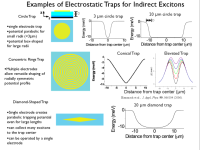
|
We report on the principle and realization of a new trap for excitons -- the diamond electrostatic trap -- which uses a single electrode to create a confining potential for excitons. We also create elevated diamond traps which permit evaporative cooling of the exciton gas. We observe collection of excitons towards the trap center with increasing exciton density. This effect is due to screening of disorder in the trap by the excitons. As a result, the diamond trap behaves as a smooth parabolic potential which realizes a cold and dense exciton gas at the trap center. A. A. High, A. K. Thomas, G. Grosso, M. Remeika, A. T. Hammack, A. D. Meyertholen, M. M. Fogler, L. V. Butov, M. Hanson, and A. C. Gossard, Trapping Indirect Excitons in a GaAs Quantum-Well Structure with a Diamond-Shaped Electrostatic Trap, arXiv:0906.0639v1 (2009) ; Phys. Rev. Lett. 103, 087403 (2009). |
Elevated traps |
|
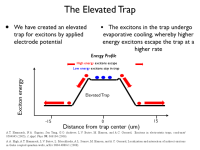
|
We introduced an elevated trap technique and exploited it for lowering the effective temperature of indirect excitons. We observed narrow photoluminescence lines, which correspond to the emission of individual states of indirect excitons in a disorder potential. We studied the effect of exciton-exciton interaction on the localized and delocalized exciton states and found that the homogeneous line broadening increases with density and dominates the linewidth at high densities. A.A. High, A.T. Hammack, L.V. Butov, L. Mouchliadis, A.L. Ivanov, M. Hanson, and A.C. Gossard, Indirect excitons in elevated traps, arXiv:0804.4886v1 (2008); Nano Lett., 9 (5), 2094 - 2098 (2009). |
Electrostatic traps for excitons |
|
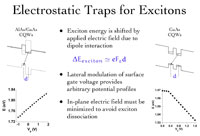
|
Our electrostatic exiton traps are based on the quantum confined Stark effect. An electric field Fz perpendicular to the QW plane results in the exciton energy shift δE = eFzd, where d is the exciton dipole moment. For indirect excitons in coupled quantum wells (CQWs) electrons and holes are separated in different QWs and d is approximately the distance between the QW centers. An applied laterally modulated gate voltage Vg(x,y) creates a laterally modulated electric field and, in turn, a lateral relief of the exciton energy δE(x,y) = eFz(x,y)d. Control of Vg(x,y) allows manipulation of the in-plane potential profile for excitons both in space and in time. However, an intrinsic obstacle for exciton confinement in the electrostatic traps is an in-plane electric field Fr that can lead to exciton dissociation. A strong exciton confinement in the electrostatic traps requires a strong lateral modulation of Vg, which, in turn, can lead to a strong Fr and exciton ionization. An effective method for decreasing Fr while maintaining the general shape and strength of the trap is to use samples that are grown with the CQW much closer to the backgate contact than to the frontgate contact(s) used to apply Vg(x,y). A.T. Hammack, N.A. Gippius, Sen Yang, G.O. Andreev, L.V. Butov, M. Hanson, and A.C. Gossard, Excitons in electrostatic traps, cond-mat/0504045 (2005); J. Appl. Phys. 99, 066104 (2006). |


